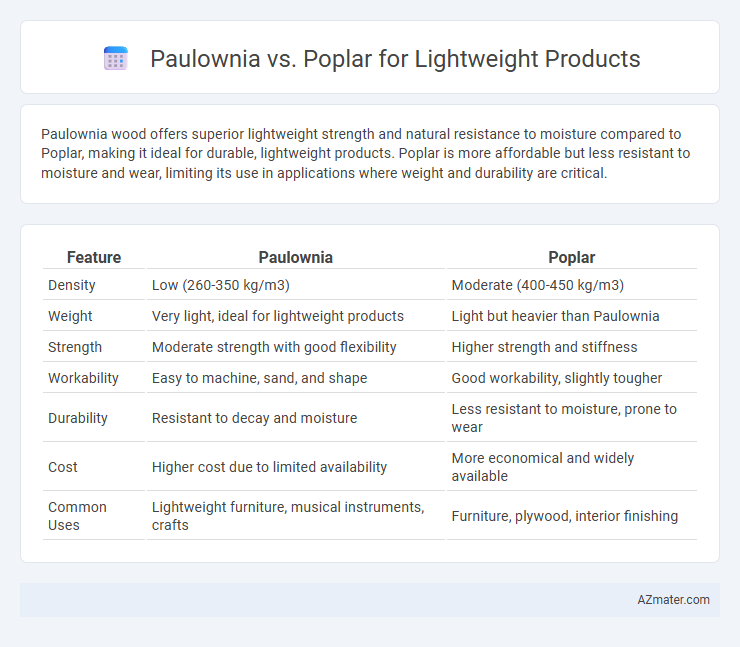Paulownia wood offers superior lightweight strength and natural resistance to moisture compared to Poplar, making it ideal for durable, lightweight products. Poplar is more affordable but less resistant to moisture and wear, limiting its use in applications where weight and durability are critical.
Table of Comparison
| Feature | Paulownia | Poplar |
|---|---|---|
| Density | Low (260-350 kg/m3) | Moderate (400-450 kg/m3) |
| Weight | Very light, ideal for lightweight products | Light but heavier than Paulownia |
| Strength | Moderate strength with good flexibility | Higher strength and stiffness |
| Workability | Easy to machine, sand, and shape | Good workability, slightly tougher |
| Durability | Resistant to decay and moisture | Less resistant to moisture, prone to wear |
| Cost | Higher cost due to limited availability | More economical and widely available |
| Common Uses | Lightweight furniture, musical instruments, crafts | Furniture, plywood, interior finishing |
Introduction to Paulownia and Poplar
Paulownia wood, renowned for its exceptional lightness and strength, is commonly utilized in lightweight products such as furniture and musical instruments due to its fast growth and sustainable properties. Poplar, a moderately lightweight hardwood, offers affordability and workability, making it a popular choice for applications like plywood, crates, and interior furnishings. Both species provide distinct advantages in lightweight construction, with Paulownia excelling in weight-to-strength ratio and Poplar favored for economic versatility.
Botanical Overview and Origin
Paulownia, native to East Asia, belongs to the Paulowniaceae family and is renowned for its rapid growth and lightweight, softwood properties, making it ideal for lightweight products. Poplar, from the Salicaceae family, originates primarily in North America, Europe, and Asia and offers a slightly denser wood with good strength-to-weight ratio suitable for similar applications. Both species exhibit fast growth and yield sustainable timber, but Paulownia's lower density and high strength make it preferable for ultra-lightweight manufacturing.
Wood Density and Weight Comparison
Paulownia wood features an exceptionally low density, typically around 0.28 to 0.35 g/cm3, making it one of the lightest hardwoods ideal for lightweight products. In comparison, poplar has a higher density range of approximately 0.4 to 0.5 g/cm3, which results in greater overall weight for the same volume. This significant difference in wood density means paulownia offers superior weight savings and ease of handling for applications where minimizing weight is crucial.
Strength and Durability Differences
Paulownia wood is significantly lighter and stronger than poplar, offering a superior strength-to-weight ratio ideal for lightweight product applications. Poplar tends to be less dense, resulting in lower durability and resistance to wear compared to the more resilient and stable Paulownia. The higher tensile strength and dimensional stability of Paulownia make it better suited for products requiring long-term durability without added weight.
Workability and Machining Qualities
Paulownia wood offers superior workability and machining qualities compared to poplar, making it ideal for lightweight products requiring precise shaping and finishing. Its fine, straight grain and softer texture allow for easy cutting, sanding, and drilling, reducing tool wear and enhancing surface smoothness. Poplar, while also lightweight, has a coarser grain and slightly higher density, which can lead to increased resistance during machining and a rougher finish.
Sustainability and Environmental Impact
Paulownia wood offers superior sustainability due to its rapid growth rate, high carbon sequestration, and minimal water requirements compared to poplar, making it a more eco-friendly option for lightweight products. Poplar, while fast-growing, requires more intensive water and nutrient inputs, resulting in a higher environmental footprint. The lightweight properties of paulownia combined with its ability to regenerate quickly and improve soil quality position it as a leading choice for environmentally conscious manufacturing.
Moisture Resistance and Dimensional Stability
Paulownia wood exhibits superior moisture resistance compared to Poplar, making it highly suitable for lightweight products exposed to varying humidity levels. Its dimensional stability remains consistent under moisture fluctuations, reducing warping and swelling risks commonly seen in Poplar. These properties position Paulownia as the preferred choice for applications requiring lightweight yet durable materials with enhanced longevity in humid environments.
Cost and Availability Analysis
Paulownia wood is often more expensive than poplar due to its slower growth cycle and limited regional availability, making it a premium choice for lightweight products requiring strength and durability. Poplar offers a cost-effective alternative with widespread availability and faster replenishment rates, which supports large-scale production of lightweight goods. When balancing cost and supply reliability, poplar is generally favored in budget-sensitive markets, while paulownia suits niche applications demanding superior performance despite higher prices.
Best Applications for Lightweight Products
Paulownia wood offers exceptional lightweight properties combined with high strength, making it ideal for applications such as model making, lightweight furniture, and musical instruments where durability and ease of handling are crucial. Poplar, while also lightweight, provides greater stability and consistency in grain, which suits it well for packaging, plywood, and interior millwork where smooth finishes and uniformity are required. Choosing between Paulownia and Poplar depends on specific product requirements like weight, strength, and appearance in lightweight product design.
Conclusion: Choosing the Right Wood
Paulownia offers superior lightweight properties with a density around 260 kg/m3, making it ideal for applications requiring high strength-to-weight ratios compared to Poplar, which has a higher density averaging 450 kg/m3. Its rapid growth and resistance to warping further enhance its suitability for lightweight products such as surfboards and musical instruments. Poplar remains a versatile hardwood for furniture and cabinetry but is less optimal when extreme lightness is a priority.

Infographic: Paulownia vs Poplar for Lightweight Product
 azmater.com
azmater.com